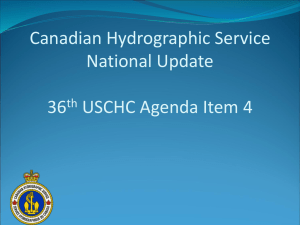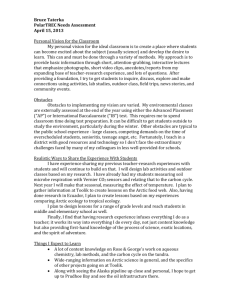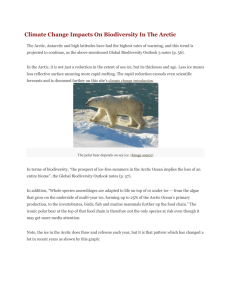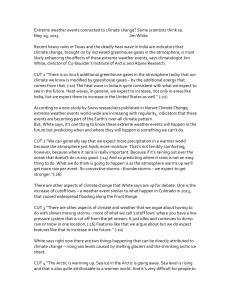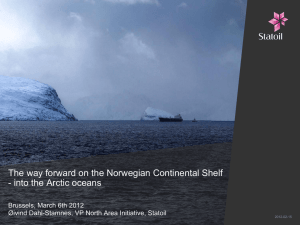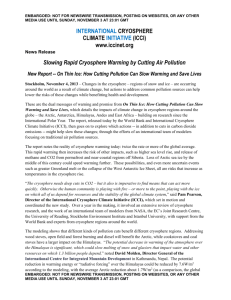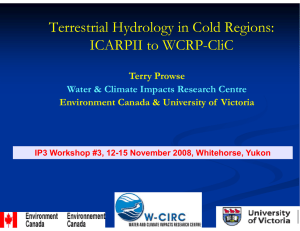Arctic Societies, Cultures, and Peoples in a Changing Cryosphere
advertisement
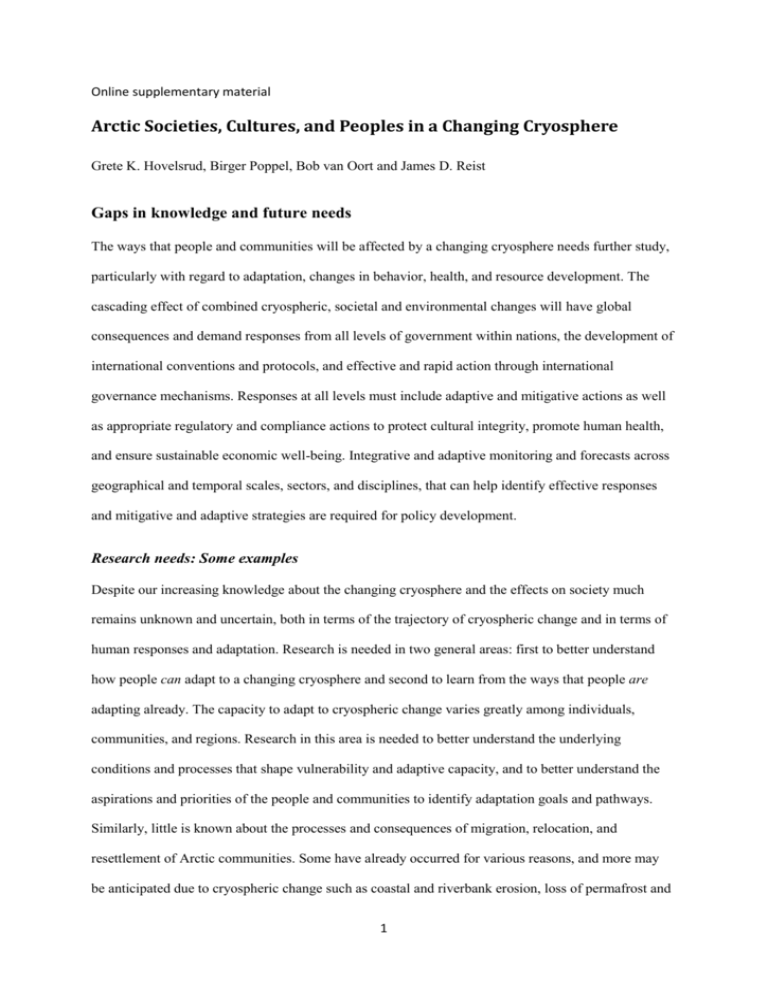
Online supplementary material Arctic Societies, Cultures, and Peoples in a Changing Cryosphere Grete K. Hovelsrud, Birger Poppel, Bob van Oort and James D. Reist Gaps in knowledge and future needs The ways that people and communities will be affected by a changing cryosphere needs further study, particularly with regard to adaptation, changes in behavior, health, and resource development. The cascading effect of combined cryospheric, societal and environmental changes will have global consequences and demand responses from all levels of government within nations, the development of international conventions and protocols, and effective and rapid action through international governance mechanisms. Responses at all levels must include adaptive and mitigative actions as well as appropriate regulatory and compliance actions to protect cultural integrity, promote human health, and ensure sustainable economic well-being. Integrative and adaptive monitoring and forecasts across geographical and temporal scales, sectors, and disciplines, that can help identify effective responses and mitigative and adaptive strategies are required for policy development. Research needs: Some examples Despite our increasing knowledge about the changing cryosphere and the effects on society much remains unknown and uncertain, both in terms of the trajectory of cryospheric change and in terms of human responses and adaptation. Research is needed in two general areas: first to better understand how people can adapt to a changing cryosphere and second to learn from the ways that people are adapting already. The capacity to adapt to cryospheric change varies greatly among individuals, communities, and regions. Research in this area is needed to better understand the underlying conditions and processes that shape vulnerability and adaptive capacity, and to better understand the aspirations and priorities of the people and communities to identify adaptation goals and pathways. Similarly, little is known about the processes and consequences of migration, relocation, and resettlement of Arctic communities. Some have already occurred for various reasons, and more may be anticipated due to cryospheric change such as coastal and riverbank erosion, loss of permafrost and 1 sea level rise. This question involves local dimensions (in terms of individual experiences) and regional and national dimensions (in terms of the ability of governments to support the construction and establishment of new community sites if needed). Such changes need to be considered against the backdrop of urbanization around the Arctic. The loss of sea ice in particular has generated considerable international interest in Arctic natural resources as well as the strategic importance of the region. The global significance of Arctic shipping routes remains uncertain, and the prospects for exploiting many resources depend greatly on worldwide market forces, not just on physical access. The Arctic remains remote and cold, and the development of minerals, petroleum, and fisheries faces many challenges. As such resources are developed, optimal ways of doing so need to be determined to ensure regional and national financial well-being, political independence, and sustainability. Coastal and riverbank erosion appear to be increasing, but comprehensive assessments have not yet been carried out on the vulnerability of Arctic communities and infrastructure to such erosion. Ice roads allow a relatively inexpensive, low-impact means of getting equipment and supplies to remote locations in the Arctic and to connect communities without year-round road access. The use of ice roads depends on lasting, reliable ice, and in a warming climate the reliability and duration of ice roads may diminish. More research is needed to examine the economic and social roles of ice roads, the vulnerability of ice roads to a changing cryosphere, and the prospects for alternatives. A changing cryosphere may remobilize contaminants and other air and water pollutants, increasing the availability of these substances to humans either directly or indirectly through the food web. In addition, retreat of glaciers and declining snow cover may lead to more dust in the air from wind events, adding another health stressor. More research is needed on the health effects of a changing cryosphere, in part to help health care professionals recognize and respond to new trends in health. The safety and well-being of Arctic residents may also be affected by a changing cryosphere. Different conditions on land and at sea, and different patterns of fish and wildlife distribution may increase risks, especially if local knowledge about the changing conditions cannot keep pace with the rate of 2 change. More study is needed on risk perception, risk avoidance, and knowledge production in Arctic communities to help determine how to foster effective adaptation. This work should also examine how instrumental and modeling data can be provided to Arctic residents to facilitate decisions about their daily activities. In some areas, hydrocarbon and mining developments are a greater threat to indigenous resilience than a changing cryosphere. In order to understand the impact of such developments on indigenous peoples, it is necessary to investigate changing conditions in combination with consequences for developments and across local, national, and international scales. Observation, monitoring, modeling, and downscaling needs A key contributor to effective adaptation is reliable information about the consequences of cryospheric change for a locale. While environmental conditions cannot be projected accurately, information on likely future trends and events is nonetheless useful for planning. In addition, real-time information can help reduce risks from hazards such as icebergs, floods, and severe storms. A major challenge is to provide such information on temporal and spatial scales relevant to the users. Another is to map and integrate local and traditional knowledge into monitoring and observations. Needed monitoring efforts include improved mapping, surveillance, and monitoring of drifting ice and icebergs, annual variations in ice cover, and continuing local sea-ice formation along with the frequency of storm surges, wave heights, and wind. For hunting activities that are particularly sensitive to snow and ice conditions, knowledge of changes in the timing and amount of snow is important. Monitoring snow cover, winter thaw, and rain will also provide information relevant for hydropower and risks related to drought, snow load, avalanches, and floods. In addition, people in the Arctic need information on qualified changes in snow conditions, such as maximum accumulations for snow load calculations, water supply, flood management, avalanche risk, and snow clearing for permafrost stabilization to adapt (Allard et al. 2007). Monitoring existing structures built on permafrost, follow-up of historical data, and back calculation of known failures are important to gain a better understanding of the ways such structures are affected. 3 There is a need to survey areas of thawing permafrost to secure the archeological archives of the past. The need for monitoring extends to the consequences of increased shipping, tourism, and industrial activity such as pollution, emissions, navigation impacts on marine species, and introduction of nonindigenous organisms through ballast water exchanges. Further development of downscaling techniques to map future cryospheric changes relevant at local and regional levels is essential. Adaptation is predominantly a local process and local projections of climate and cryospheric conditions are required. The development of and input to local climate projections will benefit from increased cooperation between scientists and local and indigenous communities. Adaptation to changing cryospheric conditions and their impacts will be aided by downscaled projections of future conditions that capture locally relevant changes. To be successful, this requires involvement of local people, indigenous and non-indigenous, to identify the most relevant cryosphere (or climate) elements (Hovelsrud and Smit,2010). Projections of specific parameters will need to cover relevant seasons and time scales. Incorporating local/traditional knowledge in the interpretation of satellite-derived snow and ice cover products and in the development of communitybased monitoring programs will provide data for scenario development and enhance community involvement and decision-making. Local focus and traditional and local knowledge are essential in studies on and for adaptation (Krupnik et al. 2010; Hovelsrud and Smit 2010). Meeting governance and technology needs An increase in human activities such as fisheries, tourism, and industrial development will increase the demand for seasonal ice-breaking of harbors and routes, and improved environmental regulations, safety preparedness and response, waste and pollution control, marine charting, and weather and ice forecasting. Improved disaster management and training of local search and rescue personnel are of key importance (Chircop 2009). To minimize impacts on wildlife, hunting and fisheries, careful consideration of cruise tourism transport schedules in relation to such activities are critical for ensuring the cultural and economic well-being of Arctic peoples (UNEP 2007). 4 There are clear limits to any Arctic governance regime (regulatory or soft-law), because the drivers of cryospheric change mainly occur outside the region and fall beyond the jurisdiction of any one Arctic state. Current changes signal the need for effective interplay across societal levels and scales between Arctic institutions and existing regimes (Stokke and Honneland 2007; Young 2009). In addition, there is a clear need for further monitoring and the use of monitoring data in knowledge co-production and shared learning (Riedlinger and Berkes 2001; Laidler and Elee 2006). The wide-ranging changes, when combined with the changes resulting from cryospheric shifts, will result in numerous challenges associated with all aspects of Arctic development. Managing such changes sustainably represents a further challenge particularly in the context of developmental cascades. To achieve orderly development, effective governance strategies must address not only the changes anticipated and responsive adaptive or mitigation measures, but also future opportunities. Appropriate regional-scale management bodies may be required to integrate and assess the totality of changing environments (cryosphere and climate) and developmental plans over varying timescales. Representation of indigenous peoples and other Arctic residents on such decision-making bodies is imperative. References Allard, M., R. Fortier, D. Sarrazin, F. Calmels, D. Fortier, D. Chaumont, J.P. Savard and A. Tarussov. 2007. The impact of global warming on airports in Nunavik: characteristics and characterization of permafrost degradation of tracks (In French). Final report. 199 pp. Ouranos Consortium. Chircop, A. 2009. The Growth of International Shipping in the Arctic: Is a Regulatory Review Timely? The International Journal of Marine and Coastal Law 24:355-380. Hovelsrud, G.K. and B. Smit. 2010. Community Adaptation and Vulnerability in the Arctic Regions. Springer Publishers. Krupnik, I., C. Aporta, S. Gearheard, G.J. Laidler and L. Kielsen-Holm . 2010. SIKU: Knowing Our Ice: Documenting Inuit Sea Ice Knowledge and Use. Springer. 5 Laidler, G. and P. Elee. 2006. Sea Ice Processes and Change: exposure and Risk in Cape Dorset, Nunavut. In Climate Change: Linking traditional and scientific knowledge, ed Riewe, R. and J. Oakes, pp. 155-175. Winnipeg: Aboriginal Issues Press, University of Manitoba. Riedlinger, D. and F. Berkes. 2001. Contributions of traditional knowledge to understanding climate change in the Canadian Arctic. Polar Record 37:315-328. Stokke, O.S. and G. Honneland 2007. International cooperation and Arctic governance: regime effectiveness and northern region building. London: Routledge. UNEP. 2007. Tourism in the Polar Regions. The Sustainability Challenge. 68 pp. United Nations Environment Programme and The International Ecotourism Society. UNEP, Arendal, Norway 68 pp. Young, O. R. 2009. The Arctic in play: governance in a time of rapid change. The International Journal of Marine and Coastal Law 24:423-442. 6



